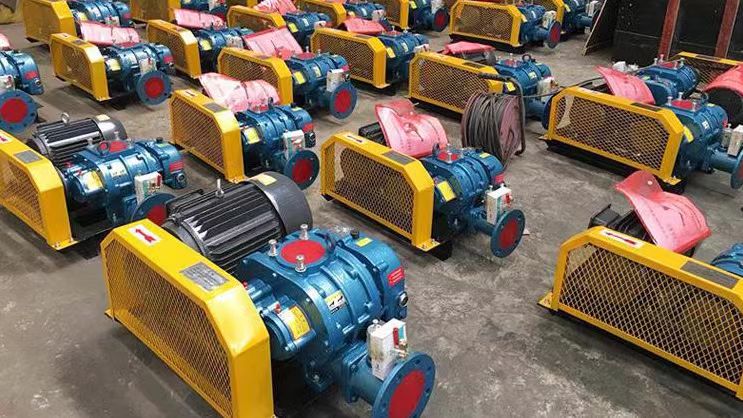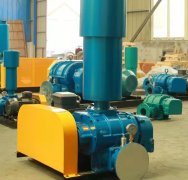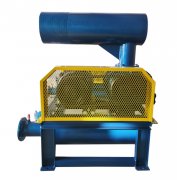**Installation guide for Roots blower**
The correct installation of Roots blower directly affects its operating efficiency, vibration and noise level, and service life. The following are detailed installation steps and precautions.
---

**1. Preparation work before installation**
**(1) Check the fan and accessories**
-Check whether the fan model and specifications meet the design requirements (air volume, pressure, power, etc.).
-Check whether the appearance of the fan is intact, whether the impeller rotates flexibly, and whether there is any transportation damage.
-Confirm that the supporting accessories (anchor bolts, shock absorbers, inlet and outlet mufflers, soft connections, etc.) are complete.
**(2) Basic requirements**
-* * Basic strength * *: The concrete foundation needs to be able to withstand the weight of the fan (usually ≥ 1.5 times the weight of the equipment) to avoid settlement.
-Levelness: The basic surface levelness error is ≤ 0.2mm/m, which can be detected with a spirit level.
-* * Pre embedded foundation bolts * *: The position is accurate, and the bolt size meets the requirements of the fan base (or fixed with chemical anchor bolts).
**(3) Pipeline layout**
-Import and export pipelines should be independently supported to prevent external forces from being transmitted to the fan.
-The diameter of the pipeline should be greater than or equal to the inlet and outlet diameter of the fan to reduce airflow resistance (avoid sharp bends or diameter reduction).
-Install * * soft connections * * (rubber or bellows) to absorb vibration and thermal displacement.
---
**2. Installation steps**
**(1) Fan in place**
-Use lifting equipment (such as forklifts, cranes) to place the fan steadily on the foundation.
-Do not drag or impact directly to avoid damaging the impeller and housing.
**(2) Adjusting levels and alignment**
-Use a spirit level to check the levelness of the fan base (both axial and radial adjustments are required).
-If using * * shock absorbers * * (such as rubber shock pads or spring shock absorbers), it is necessary to ensure that all shock absorbers are evenly stressed.
**(3) Fixed foundation bolt**
-Preliminarily tighten the anchor bolts and perform rough adjustment.
-Perform secondary grouting (if necessary) and wait for the concrete to solidify (usually 48 hours) before finally tightening the bolts.
**(4) Connecting pipelines**
1. Import and export pipelines**
-Install * * soft connections * * (to reduce vibration transmission), and add sealing gaskets (such as asbestos or rubber gaskets) when flange docking.
-Ensure the coaxiality between the pipeline and the fan to avoid stress concentration caused by forced centering.
2. * * Muffler/Filter**
-If the system is equipped with a muffler or filter, it should be installed near the inlet and outlet of the fan (in the order required by the manufacturer).
**(5) Electrical wiring**
-Connect the wires according to the requirements of the motor nameplate (matching voltage, phase, and power).
-Check the rotation direction (the impeller of the Roots blower must rotate in the same direction as the housing label, otherwise it will damage the blower).
-* * Trial rotation method * *: Jog the motor and observe the direction of rotation (usually clockwise, as indicated by the arrow).
**(6) Lubrication and Protection**
-Gearbox: Add specified lubricating oil (such as ISO VG220 gear oil) to the centerline of the viewing window.
-* * Bearing * *: Check the lubricating grease (such as lithium based grease) and regularly replenish it after operation.
-* * Protective Cover * *: Install belt/coupling protective cover to ensure compliance with specifications.
---
**3. Debugging and trial operation**
**(1) No load test**
1. Dismantle the inlet and outlet pipelines (or open the bypass valve) to ensure no-load start-up.
2. Start by tapping and check:
-Is the motor current normal.
-Is there any abnormal vibration or noise.
-Whether the impeller is scraping against the shell (friction sound indicates improper installation).
3. After running for 30 minutes, check the bearing temperature (≤ 70 ℃) and the condition of the lubricating oil.
**(2) Load operation**
1. Gradually close the vent valve and increase the system pressure to the rated value.
2. Monitoring:
-Air volume/pressure: Does it meet the design requirements.
-Vibration value: detected with a vibration meter (usually ≤ 4.5mm/s).
-* * Noise * *: When exceeding the standard, it is necessary to check the muffler or pipeline support.
---
**4. Common installation problems and solutions**
|* * Problem * * | * * Possible Cause * * | * * Solution * *|
|-------------------------|-----------------------------|--------------------------------|
|* * High vibration * * | Weak foundation/high pipeline stress | Strengthen the foundation, check the soft connections and supports. |
|* * Abnormal noise (metal friction) * * | Collision between impeller and shell | Adjust impeller clearance and check alignment. |
|Motor overload | High pipeline resistance/incorrect direction | Check valve opening, direction, and system resistance. |
|Oil leakage * * | Seal ring damaged or oil level too high | Replace seal and adjust oil level. |
---
**5. Precautions**
-* * It is strictly prohibited to start under pressure * *: Before starting, ensure that the inlet and outlet valves are in the open state (or vented).
-Explosion proof environment: Explosion proof motors and grounding are required for chemical, coal mining and other scenarios.
-* * Regular maintenance * *: Change the oil for the first time after 500 hours of operation, and replace it every 3000 hours thereafter.
---
**Summary**
-* * Core points * *: Stable foundation, precise alignment, stress free pipeline, and correct steering.
-* * Key steps * *: Horizontal adjustment → Soft connection installation → Trial steering → Load debugging.
-* * Maintenance suggestion * *: Regularly check the lubricating oil, vibration, and sealing status.
Installing according to the above process can ensure the stable operation of the Paulz fan and extend its service life. If there are special working conditions (such as high temperature, corrosive gases), additional protective measures need to be taken.



